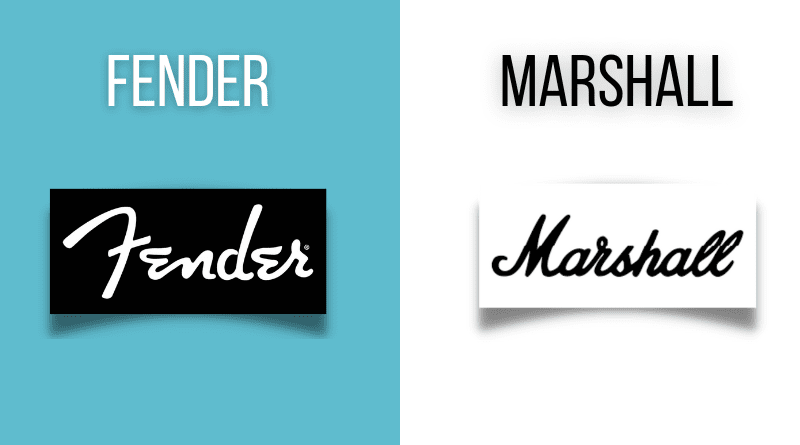In the world of amplification, there are dozens of manufacturers; from budget makers to boutique brands, and amongst those many brands many rivalries have been formed. Of those rivalries, none stands out quite like that of Fender vs Marshall – these are two major brands that have been duking it out for decades; literally.
Of course, both brands have their diehard fans – but for those not assigned to either tribe, you might be wondering who makes better amps – Fender or Marshall?
In this KillerGuitarRigs Guide, we’ll take a look at the history of both brands. We’ll compare and contrast their most popular models, and we will try to objectively help you figure out which is the better choice for you.
If you’re undecided as to whether you want to join Team Fender or Team Marshall, you’re definitely going to want to keep on reading.
Read more about our review process.
Contents
What Are the Differences Between Fender and Marshall Amps?
There are a few primary differences between Fender and Marshall amps that have come to pretty much define both brands.
Clean Headroom
Fender amplifiers, particularly their tube amps, are renowned for their massive headroom. This huge power reserve means that they need to be pushed extremely hard before they start to break up and distort. This makes them a great choice for anybody looking for an amp that can stay clean, even at extreme volumes.
Marshall amplifiers, on the other hand, are mostly known for their high gain performance. There are some models that deliver big, clean headroom, but players looking for the “Marshall Sound” want the crunch and distortion necessary for massive rock tones, and Marshall definitely delivers.
EQ Adjustment Options
When it comes to a natural EQ state, Fender’s amps tend to have well scooped mids. This puts a lot of emphasis on the treble and bass frequencies, and contributes to the smooth, glassy tones these amps are famous for.
Marshall amps have a much flatter frequency band, although when the tubes get cooking, they develop a prominent mid range hump, which is part of why they sound so incredible for heavier styles when their tubes are saturated.
Tube Types

One of the main differences between Fender and Marshall when it comes to tube amps is the type of valves they use. Fender tend to equip their amps with 6V6 power tubes, which result in a smooth response even with high gain, although they lose some attack.
Marshall’s amps are mostly fitted with EL34 power tubes, which tend to offer a more aggressive attack, with a sharp bite, and an overall darker sound.
Pedal Performance
Fender amplifiers are held in high regard for their exceptional pedal performance. Their enormous clean headroom results in a sound that won’t alter the natural character of an effects pedal, which is generally what pedal users want.
With Marshall, you’re getting amplifiers that can provide everything from mild crunch to earth shattering distortion, all on their own. So, while they may not handle pedals quite like a Fender, they still provide some amazing organic tones without the need for external FX units.
The History of Fender Amplifiers
Ever since the early years of electric guitars and amplifiers, Fender has been one of the biggest names in the business.
The Birth of the Electric Guitar Amplifier
By the 1940s, amplifier manufacturers were starting to experiment with different ways to improve the sound of their products. It was during this time that Leo Fender who had started K&F with Clayton Kaufmann, developed his first amplifier, the “Woody”, which was designed to be paired with the lap steel guitars he was producing at the time.
In 1946, Leo Fender founded the Fender Musical Instruments Company, the company that would eventually come to be known as simply “Fender”. Fender’s goal was to create affordable, quality instruments and amplifiers for both professional and amateur musicians.
After branching off from K&F to form Fender, Leo produced 3 amp models with direct relations to the original Woodys; the Princeton, the Deluxe (also known as the Model 26), and the Professional.
The British Invasion
In 1964, The Beatles appeared in America with their groundbreaking performance on The Ed Sullivan Show. While they didn’t use Fender amps (they used Vox AC50s during this performance), the event itself sparked a new interest in electric guitars among young Americans, and helped fuel a boom in sales of electric guitars and amplifiers.
Spurred on by increased sales, Fender developed and introduced several new amplifier models throughout the ‘60s, including the Twin Reverb, Super Reverb, and Princeton Reverb. These amps would go on to become classics in their own right.
A New Generation of Guitarists
The 1970s saw a new generation of guitarists emerge who were influenced by both classic rock & roll as well as newer styles like jazz fusion and punk rock. To meet the needs of these players, Fender updated the circuitry on existing amps and introduced several new models and ushered in the Silverface era. They tried to push forward with their new transistor powered solid state series, but by 1971 they abandoned non-tube amps (temporarily, at least), as the tech wasn’t anywhere near capable of producing the tones Fender was, and wanted to be, known for.
The Modern Era
In 1985, CBS sold Fender to a group of private investors led by Bill Schultz. Schultz is credited as being the man who saved Fender, and under his leadership, Fender began producing a wide range of different amp types including both budget and high end solid state models, as well as more traditional tube amps. Today, Fender continues to be one of the most respected names in amplification.
Fender amplifiers have been an integral part of popular music for nearly 50 years now. What started out as a quest to create affordable, quality instruments, has evolved into a commitment to innovation that has truly changed the sound of music across genres and generations.
The History of Marshall Amplifiers
If you’ve ever turned on a radio, watched a music video, or been to a concert, chances are you’ve heard a Marshall amplifier. But how did this company go from a small startup in England to becoming one of the most famous names in the music industry?
The Early Years
Marshall Amplifiers was founded in 1962 by three men; Jim Marshall, Terry Marshall, and Ken Bran. Starting out, they initially sold guitar strings, drumsticks, and other musical equipment out of their shop in London.
None of the three were guitarists, but sensing an opportunity after hearing many of their customers complain that they couldn’t get the tone they wanted from the amplifiers of the day, they had a go at making their own. Their first amplifier, the JTM45, was an instant hit with local musicians, and sold 23 units on the very first day in store. Inspired by this success, they began making more amplifiers and soon started selling them internationally.
The Birth of Rock ‘n’ Roll
In 1965, Marshall released their first 100-watt Amplifier Head, the JTM45/100 Dual Output Transformer Head, which quickly became popular with rock musicians. This amplifier was used by some of the most famous bands of the time, including The Who, Cream, and Jimi Hendrix. This success led to the development of their “Plexi” amps, which were so called due to their perspex panels on the front and back.
These particular amplifiers are now some of the most sought after pieces of guitar equipment on the planet, mainly down to the fact that they literally defined the sound of practically every famous rock band of the era.
The Modern Era
In the early 1970s, Marshall introduced a new line of amplifiers, known as “Master Volume” amps. These amplifiers, particularly the JMP2203, were less raucous than previous models, and allowed for more control over the volume and overall sound.
In 1987, Marshall released their legendary Silver Jubilee amplifier to celebrate 25 years in business. This amp quickly became popular among hard rock and metal guitarists.
In 1992 Marshall moved its operations from London to Bletchley in Milton Keynes, where they continue to make their high end products, although their more affordable models are now made overseas.
Despite the arrival of modeling amps and plugins that can accurately replicate famous amps like the Plexi series, Marshall remains one of the most popular amp brands on the market. From their early days making amplifiers for local bands to becoming one of the go-to brands for rock and roll legends around the world, Marshall has solidified its place in music history, and like Fender, has no doubt had a huge hand in shaping the sound of music as we know it today.
Best Fender Amps: Our Top 3
If you’ve decided to lean towards Fender for your next amp, here are our top 3 choices. We’ve picked out our favorite tube model, our favorite solid state model, and our favorite budget choice.
Fender ’68 Custom Princeton Reverb 1×10″
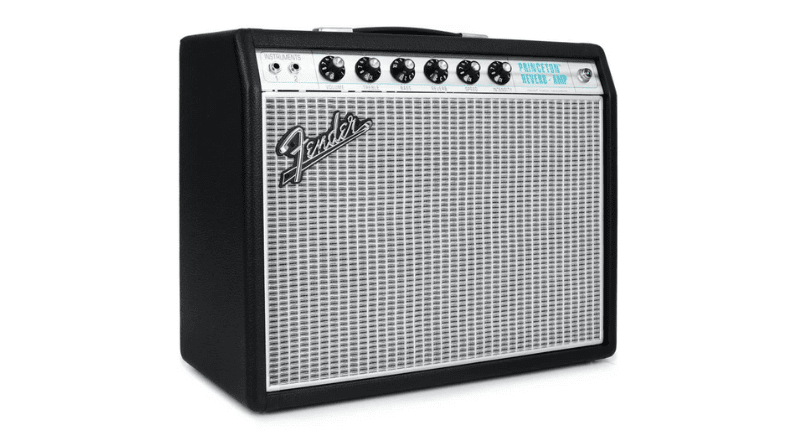
For many guitarists, the holy grail of amplifiers is a vintage Fender. The clean tones and lush reverb of these amps have been heard on some of the most famous recordings in history. Unfortunately, vintage Fenders are notoriously difficult to find and can be incredibly expensive. Enter the Fender ’68 Custom Princeton Reverb 1×10″, a tribute to the classic amplifier that captures all the warmth and character of its predecessor while being much more affordable and reliable.
The ’68 Custom Princeton Reverb is a 12 watt combo fitted with a 10″ Celestion Ten 30. It has plenty of power for small gigs, and all the mojo you’ll ever need. It’s built with all-tube circuitry, including 3 12AX7 tubes and a 12ATZ in the preamp stage, plus 2 6V6 power tubes and a 5AR4 rectifier. People say this makes the ’68 a little more versatile compared to the ’65 Princeton Reverb (which pairs especially well with a tele), which has the same tubes as the ’68, with the exception of a 12AT7 in place of the 12ATZ, plus a 12″ Eminence Cannabis Rex speaker, and is a little more sparkly in the top end and reserved in the mids.
Despite having just 12 watts, this array of tubes ensures the huge headroom and glistening cleans that you’d expect from a Fender amp.
Fender Tone Master Deluxe Reverb 1×12″

While Fender is famous for their tube amps, they aren’t for everybody. Fender also makes a number of excellent solid state amps, including the Fender Tone Master Deluxe Reverb 1×12″. This is at the upper end of the price range for a solid state Fender, but believe us when we say it’s absolutely worth every penny.
It’s a powerhouse of an amp at 100 watts, and all that power is pushed through its awesome Jensen N12K speaker. One of the biggest benefits of opting for the Tone Master is that it delivers the classic Fender cleans, but weighs just 12lb. For an amp this powerful, that is an absurdly light weight.
Its overall sound quality is absolutely fantastic, and if it wasn’t for the Tone Master logo on the grille cloth, you’d likely never be able to spot the difference between this and a vintage Deluxe Reverb.
Fender Mustang LT 25 1×8″
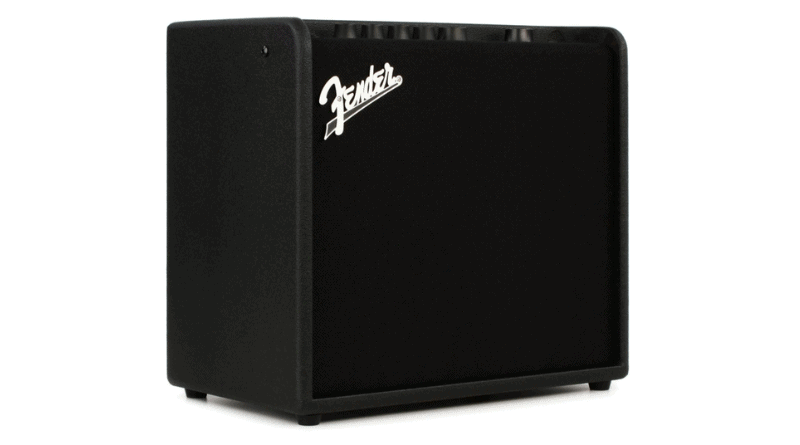
Fender doesn’t just make expensive amps for working musicians and advanced players. In fact, one of our absolute favorites is also one of their most affordable models, the Fender Mustang LT 25.
The Fender Mustang LT 25 1×8″ combo amplifier is a great choice for beginner guitarists, but it also works well for more experienced players looking for something inexpensive. It’s a 25 watt modeling amp with a single 8” speaker that delivers plenty of punch for at home practice and even low key jams with friends (and there’s always the Mustang Micro if you want to go smaller).
It features 30 presets, with many thousands more available to download from the internet, and its USB out port means it can even be used as a recording interface.
Best Marshall Amps: Our Top 3
If you think Marshall is the way to go for your next amp, check out our three favorites (or read our full breakdown). We’ve included models from budget to high end, and of course, in between.
Marshall SV20C Studio Vintage 1×10”
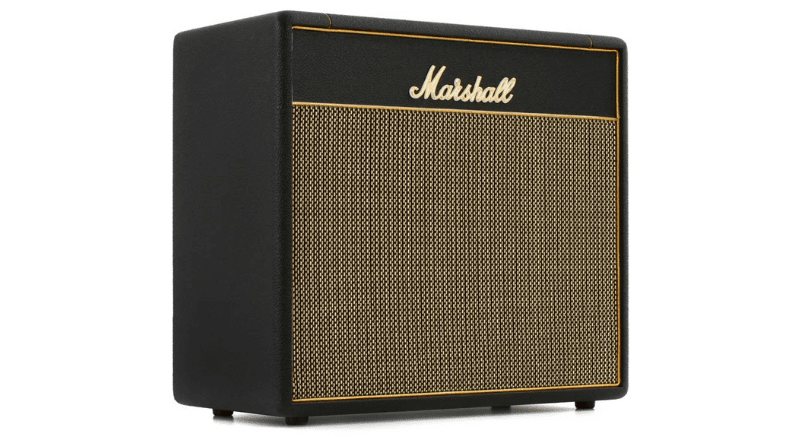
If you’re looking for a high-end Marshall tube combo, they don’t much better than our favorite, the Marshall SV20C Studio Vintage. This amp packs all of the incredible Plexi tone of the original 1959 Super Lead, hailed by many as the epitome of the rock sound, and compresses it into a usable 10” combo amp.
It features three 12AX7 preamp tubes and 2 EL34s in the power section, delivering 20 watts of power that can be attenuated down to 5 for incredible crunch at more sociable volumes. With such versatility, this amp is perfect for practice or even small to medium-sized gigs.
Its 10″ Celestion V Type speaker is perfectly paired and delivers great tones across the entire frequency range. The three-band EQ lets you shape your sound, and the presence control adds clarity to your tone. This amp also features a line out, so if you want to hook it up to a stack, it’s a super easy process.
Marshall DSL20CR
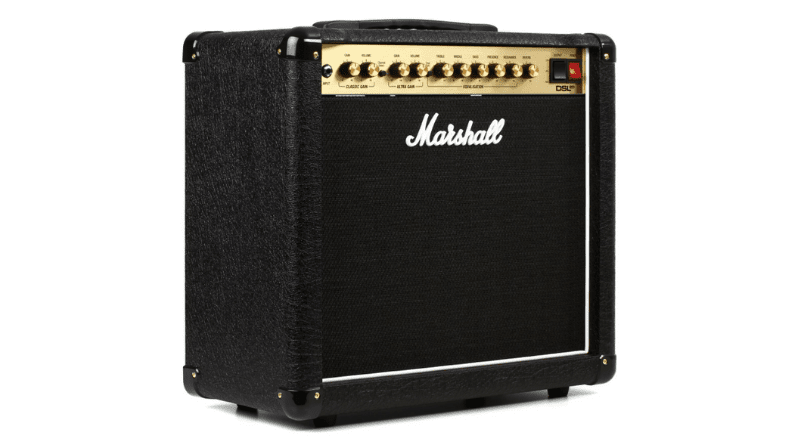
The Marshall DSL20CR was released in 2018, and since then it has become one of the most popular amps in its price range. It’s an all tube beast that’s at home wherever it’s needed, be that at home, the studio, or on the stage.
The DSL20CR is an all tube beast of an amplifier with a 20-watt output through its 12” Celestion Seventy 80 speaker, and in typical Marshall fashion, it features 3 ECC83 preamp tubes and 2 EL34 power tubes.
Between the individual volume and gain controls for the two channels (classic gain and ultra gain) and the master volume control, this amp delivers a huge range of tones that far surpass what you might expect of an all tube Marshall. It doesn’t have quite the same headroom as a Princeton Reverb, but it’s got enough to keep the average user happy.
For tone shaping, there is a 3 band EQ, as well as presence, resonance, and reverb controls. With this much control over the sound, there are very few genres it can’t tackle, but there’s also no denying that this amp is a monster when it comes to high gain hard rock and metal.
Marshall MG15GFX
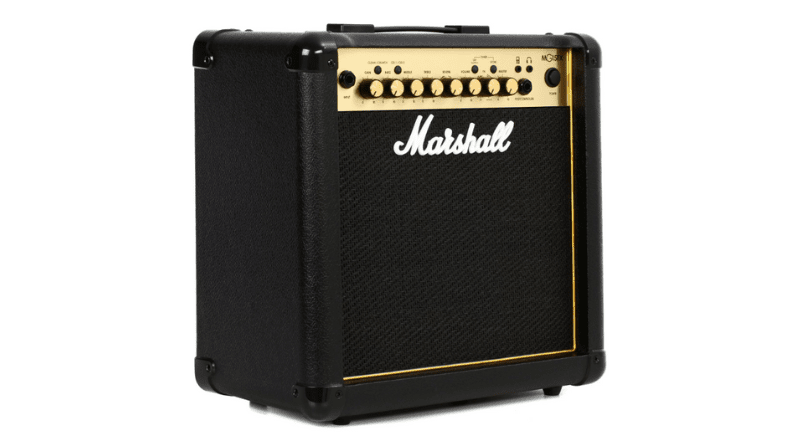
Anybody looking for a great amp that won’t break the bank will love the Marshall MG15GFX. For not a lot of money you’re getting a genuine Marshall with a ton of features that make it a perfect practice combo amp.
The MG15GFX is a solid state amplifier with a 15 watt output and it has a whopping 4 channels (clean, crunch, overdrive 1 and overdrive 2). It features 3 band EQ adjustment, and even boasts a range of built in FX and a tuner. It pushes air through a Marshall exclusive custom 8” speaker, which delivers a surprisingly full frequency response considering the smaller size.
Being solid state, the MG15GFX amp serves up some great clean tones as well as the classic Marshall overdriven crunch. The clean channel is bright and crisp, while the crunch and overdrive channels go from light breakup to heavy distortion. Don’t let the fact that it’s a Marshall fool you – it’s a great all rounder that beginners and experienced players alike can squeeze a huge variety of tones from.
Final Thoughts on Fender vs. Marshall Amplifiers
There’s no doubt that Fender and Marshall are two of, if not the, biggest names in amplification. Besides the brand name rivalry, there’s the whole British vs American debate on top of that. You could even go so far as to say that due to the difference in tone between these brands, that it’s almost impossible to have any kind of apples to apples comparison.
For that reason, it’s tough to say which is the better of the two brands as a whole. What we can do is say; If you want clean tones or exceptional pedal performance, go with a Fender. If you want darker tones with punishing high gain performance and natural distortion, Marshall is the obvious choice.

